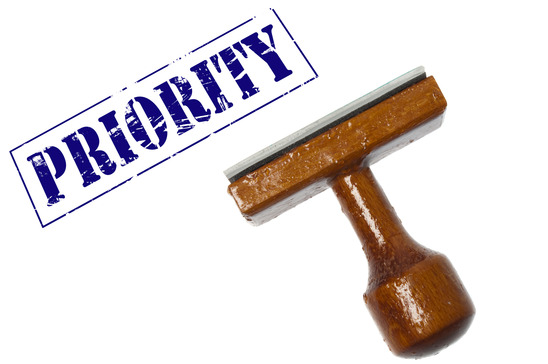Where does all the time go? Long hours. Late nights. Snatched lunches. Some people boast about their overwhelming work schedule as if it’s a badge of honor: “I start work at 7:00 a.m. and work right though until 8:00 p.m.” Often their Herculean claims border on the absurd. “Last night I went to bed at three a.m. and had to get up two hours earlier to finish a report.” Or, “I used to eat lunch at my desk. But I need to save more time, so I’m giving up eating…”
The problem is NOT that there isn’t enough time. Time doesn’t expand. The problem is that people burden themselves with too many activities. The key to success is how you allocate your time to what matters most. In time study research we’ve conducted for clients, most employees spend about 50% of their time on value-added work. But among the top performers, time spent on important activities approaches 60%. That’s an increase of 5 hours per week that can make all the difference.
SETTING PRIORITIES
Improving productivity means spending your time on the right things. And that starts with planning. Here’s what to think about when you plan your day. Ask yourself, if you had nothing else to do tomorrow, what would you do to affect your results one month from now? The answers would be your “A” priorities—activities that affect your long-term results. They might include hiring a new account manager, developing a major proposal, opening a new branch location, or launching a new marketing campaign. These top priority items should take up 20 to 30 percent of your time.
“B” activities are the things you are responsible for. They are the activities in your job description that must get done today, the things that keep you busy. They might include corresponding with clients, handling claims, supervising staff, inputting data, checking contracts, shipping materials, or updating a database. For most people, “B” responsibilities represent another 30 – 40 percent of the time.
The “C” activities are requirements—those unplanned or unwritten aspects of your job that have to be done. “A” priorities are planned by you whereas “C” requirements are often planned for you. They include department meetings, routine requests, expense reports, filing, sorting, and reading updates. Our time study research using the proprietary TimeCorder device indicates that administrative tasks take up 20-25 percent of the time. Within this, paperwork alone can be five hours per week.
Travel is a “C” requirement. It has to be done, but isn’t a key factor in the success of your job. And, let’s not forget lunches and breaks. It’s ironic how people will plan a lunch meeting or coffee break to the minute. Yet they never get around to planning their major projects. Breaks are necessary—sometimes incubation time away from work can help you solve problems better. But breaks are still just “C” activities.
Finally there are “D” activities. “D” stands for delete, delay, delegate or drop. Get rid of them. They include random web surfing, handling tasks that should be delegated and reading email newsletters. Some “D” tasks are technological time hogs; fixing a photocopier jam, waiting for software to load, or accessing the help desk. Beware of them. Miscellaneous time can be as much as 5 percent of the week.
TIME TIPS
So how do you spend more time on for your high priorities? First, take the time to plan for them. The sweet spot for general planning is about 2.5 hours per week, or 10 sessions of 15 minutes each. Anything more than that and our research shows no extra impact on results.
Here’s how to plan:
Create a list of activities each day. Make a list of things to do with A, B and C priorities written beside each. Write your list in your time planner, on an app, or even on a Post-It note. At the end of the day, check off the items you’ve completed.
Be specific. When you plan your day, don’t just say, “I’ll work on the budget” or “I’ll work on my recruiting plan.” Be specific by listing activities you can complete today. You can’t do the entire budget in a day, but you can set up a spreadsheet for salaries. You can’t recruit a new employee today, but you can update the job profile.
Block your time. Schedule time for your “A” priorities first. Plan to do them when you’re at your peak and when interruptions are least likely to occur. Make an appointment in your planner, and allocate that time for high priority activities. Then, if someone asks you to meet during that time, say “Sorry, I have an appointment.” No one will ask whom it’s with. It’s an appointment with yourself.
Delegate the things that only you can do. If you think you’re the only person who knows how to do something, you’re probably mistaken and need to delegate more. And if you’re worried that someone isn’t quite ready for a new task, just remind yourself; they’re ready! Delegate the objective, the standards to be met and then ask the person what they need to get started. If they need help, they’ll let you know. Then watch them wow you with results.
Put a value on your time. People say, “time is money”, but for many of them it isn’t. They spend time to save money by driving across town just to save a dollar on a tank of gas. On the other hand, successful people spend money to save time. They’ll hire others to do the things they don’t like doing or aren’t good at. They don’t worry about spending a dollar if it will save them an hour.
Know how you spend your time. Allocate it to the things that matter most. Your time is worth it.


0 Comments